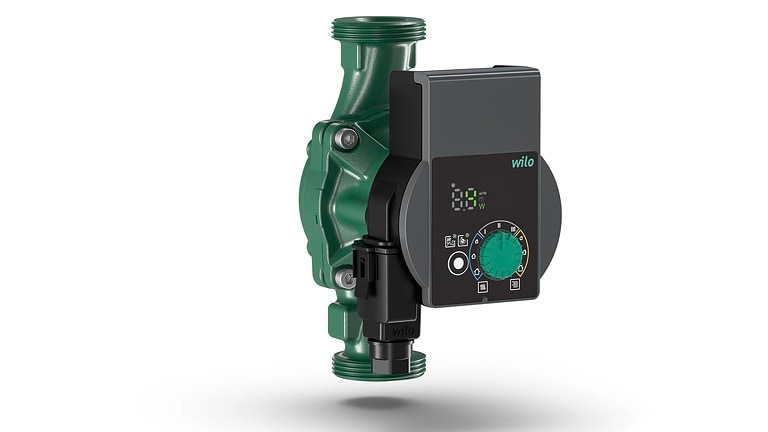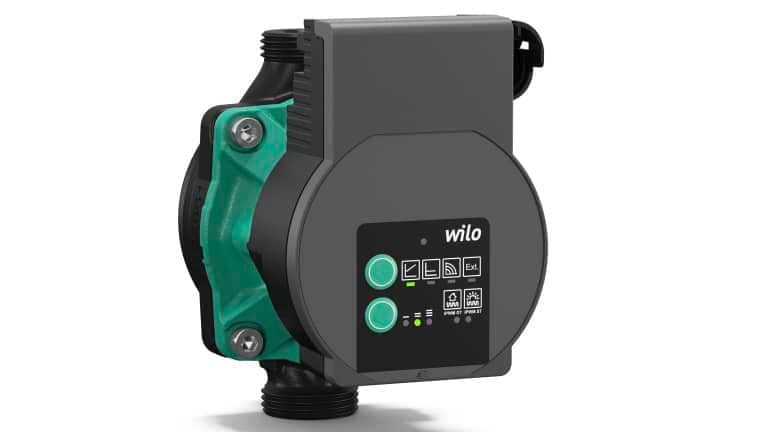Replacing circulating pumps for heating systems
The job of the central heating pump in the heating system is to move the heating water through the heating system. In doing so, it has to overcome the flow resistance of the pipeline system. Only if all radiators and heating circuits have enough flow do they function correctly. The problem is that old, fixed-speed circulating pumps with a constant speed usually deliver a volume flow that is far too high. They consume a great deal of electricity, meaning that it is worth replacing them with a new energy-saving heating pump or high-efficiency pump.
Discover our energy-saving circulating pumps here:



You can find a direct comparison of these series here:
ComparisonWhy replacing a fixed-speed circulating pump with a high-efficiency pump is more than worth it
The decision to replace the circulating pump mainly depends on the control and the motor technology and the associated electricity consumption. Old, completely fixed-speed pumps have no configuration options. They therefore consume a lot of electricity per year because unlike high-efficiency pumps, they cannot reduce their electricity consumption during operation.
Old heating pumps run at a high speed
The heating pump is the heart of your home and averages 6,000 operating hours a year. Since old pumps cannot adapt their speed to the respective conditions, they run at a higher speed than is often necessary. But it’s precisely by adjusting the speed that large amounts of electricity can be saved: the high-efficiency pump Wilo-Stratos PICO consumes up to 80 per cent less electricity compared to an outdated, fixed-speed pump. Innovative control modes such as the “Dynamic Adapt plus” function make this possible.
Replacing the heating pump – an investment that pays off in 2 to 3 years
An old, fixed-speed heating pump very probably ranks number 1 in a list of “energy guzzlers” in your home. Using a high-efficiency pump for your heating changes the picture considerably: the new, energy-efficient pump ranks below household appliances such as televisions or washing machines. Switching from a fixed-speed pump to a high-efficiency pump usually pays for itself after two to three years. A small investment with a big impact on your wallet!
A new high-efficiency pump saves up to 80 % electricity compared to old pumps
There is therefore a considerable savings potential when replacing an older, fixed-speed pump with a high-efficiency pump. As an installer, you should therefore recommend a replacement to customers with a fixed-speed circulating pump. Switching to a high-efficiency pump pays off in just a short amount of time.
Savings calculator for heating pumps
Use Wilo’s savings calculator and show your customers what savings they could be making with a high-efficiency pump compared to a fixed-speed heating pump:
Savings calculatorWhat to bear in mind as an installer when replacing the circulating pump
When you as an installer recommend the replacement of a heating pump to your customer or are hired to carry out the replacement, there are initially some basic factors that have to be clarified. The right choice of a new circulating pump depends on the performance data of the existing pump. The port-to-port length (usually 180 mm for screw-type pumps), the delivery head and the nominal connection diameter must also be taken into account. A new energy-efficient circulator or high-efficiency pump ideally has these key data and also has the same screwed connection as the existing pump.
The Wilo replacement guide provides you with important information on this:
Replacement guideOur product recommendation for pump replacement
The Wilo-Stratos PICO is groundbreaking for high-efficiency pumps with its technology and energy efficiency. You can find out here what advantages you have as an installer for replacement and commissioning:
Wilo-Stratos PICOFAQs for installers
Frequently asked questions on the replacement of old circulating pumps with new high-efficiency pumps for heating systems. Important note: a heating pump should only be replaced by experts or installers.
How can I tell if the existing heating pump should be replaced with a high-efficiency pump?
What technical aspects do I have to take into account when replacing an old pump with a high-efficiency pump?
Make sure that the new pump is compatible with the existing heating system and has the right delivery head and required volume flow. The pump should be adaptable to the actual heating requirements. Ensure that all connections are correctly wired and that the pump is set correctly to guarantee maximum energy efficiency.
What precautions should I take when replacing an old heating pump with a new high-efficiency pump?
Before starting work, switch off the power supply of the heating system and shut off the shut-off devices upstream and downstream of the pump in order to drain the section. This creates a safe working environment. Make sure that the pump is correctly aligned and that all gaskets are correctly installed in order to avoid leakages. Once work has been completed, check the function of the new pump and ensure that the heating system is properly vented.
How do I go about commissioning and adjusting the new high-efficiency pump?
When commissioning the new pump, you should first of all check the hydronic balancing of the heating system and carry it out if necessary. Then check that the pump functions correctly and check the energy consumption in order to optimise energy efficiency.
Commisioning